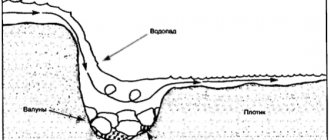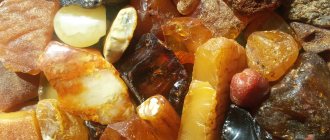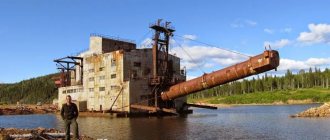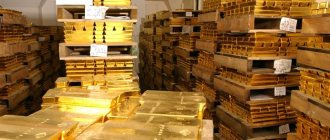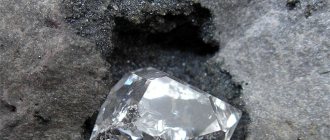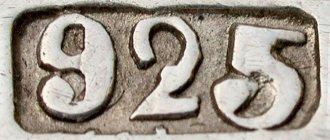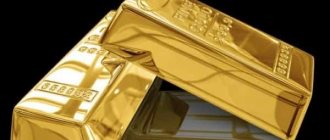Gold is rightfully considered the king among all metals. Its relative rarity, softness of forging, resistance to corrosion and the effects of large amounts of alkalis and acids place it an order of magnitude higher than other metals of the periodic table. Add to this the bright, warm, alluring sunny color that gold has in its pure form - and it immediately becomes clear who is truly worthy of “taking the metal throne.”
Unfortunately, for a long time in Russia, the extraction of this noble metal was the lot of large corporations, firms with large capacities, having all the equipment necessary for this, and also occupying vast territories for mining. However, in 2021, everything changed - an amendment appeared in the legislation allowing gold mining in Russia by individuals. Let's take a look at what exactly this is all about and whether there are any pitfalls.
On the eve of the gold rush
As already mentioned, a number of additions were made to the Russian “Law on Subsoil”, as a result of which ordinary citizens of the Russian Federation can obtain a license for gold mining. Why was this done? First of all, as official sources say, in fulfillment of the Constitution of the state, which clearly states that the wealth of the country belongs to its people. A certain social factor also played a role, namely, the standard of living of the country’s citizens in some of its regions. In particular – Chukotka.
Cut off from the ability to mine gold on their own, and in the absence of a sufficient number of jobs in the area, local residents clearly experienced financial difficulties. The new amendment will allow any local to start their own micro-business, increase personal income, and even replenish the state’s gold reserves for a decent remuneration.
Positive aspects of changes to the law “On Subsoil”
Even taking into account all these facts, many believe that the adopted law has many positive consequences:
- additional revenues to the budget - it is assumed that the government will earn about 300 kg of gold annually;
- good support for strengthening small and medium-sized businesses in provincial areas;
- creation of additional jobs and increased self-employment of the population;
- growth of residents in populated areas of sparsely populated regions.
However, the increase in the number of private miners leads to the danger of increased corruption and banditry, since this is a very convenient environment for committing crimes. Strict state control and a clear legal framework can stop such a process.
The procedure for handing over the mined precious metal will be determined after the legislative and regulatory act is approved at the federal level. Later, on the ground, government officials will be able to make the necessary changes to regional legislation.
Algorithm for obtaining a license
To become the owner of the coveted gold mining license, you must complete the following points:
- select the plot of land you are interested in at an auction held on the Rosnedra website. The site may also be offered during the competition;
- fill out an auction (competition) participant form;
- provide the event organizers, upon their request, with all necessary documents;
- win the event;
- get the desired license.
Prospects for precious metals mining
As mentioned above, gold is the basis of today's economy. Every year it is valued more and more. The jewelry industry is one of the most profitable areas in business today, and the items and products they provide are a high-status and expensive gift. This has been the case from time immemorial, and even in the age of industrial states and high information technologies, the tradition has retained its relevance. And now, with the adoption of amendments to the law, everyone can try themselves as a gold miner at the amateur level, or pave the way to the top of the most expensive industry in the world.
Sources
- https://zhazhdazolota.ru/dobycha/fizicheskimi-litsami
- https://VFinansah.com/other/dobycha-zolota-v-rossii-fizicheskimi-litsami
- https://BusinessMan.ru/dobyicha-zolota-v-rossii-fizicheskimi-litsami-kak-poluchit-litsenziyu-na-dobyichu-zolota.html
- https://promzn.ru/metallurgiya/litsenziz-na-dobychu-zolota.html
- https://yainvestor.guru/idei-investitsij/dragmetally/kak-stat-staratelem
- https://wvape.ru/dobycha/licenziya-na-dobychu-zolota.html
- https://fabricators.ru/article/licenziya-na-dobychu-zolota
- https://geomix.ru/blog/gornoe-delo/dobycha-zolota-v-rossii-fizicheskimi-litsami/
[collapse]
Contents and cost of the license
If you are, after all, a private entrepreneur and have received such a necessary document, this means that you have the right to 20 years, during which you can mine precious metals and stones on an agreed plot of land. If you also have plans to engage in geological exploration there, then another 5 years will be added to the period of 20 years. Total - 25 years to experience the craft of a miner.
In the case of private gold mining, everything is a little less rosy - only 5 years are given. You will have 15 acres of work space, which will have to be processed almost manually, with a metal detector, since the use of heavy equipment, and simply attracting additional workers for individual entrepreneurs, is prohibited. Diving to a depth of more than 5 meters is also prohibited. There is also a regulation on the mass of gold mined - up to ten kilograms.
Legal aspects of independent gold mining
Land resources can only be extracted under state control. The law requires that every miner register and pay taxes. Therefore, the extraction of precious metals is a licensed activity. Before production begins, it is necessary to register an individual entrepreneur or LLC and obtain a license and patent.
It is important to know! It doesn't matter where the river flows. Even if it is a stream in the yard of a private house, natural resources belong to the state, and they can only be extracted with special permission.
The main condition is that mined precious metals can only be sold to the state. The price is set by him, not by the miner. There is no need to count on excess profits, especially since gold ore requires additional processing. Impurities need to be removed, purified, and in some cases activated. When extracting technical gold from sand at home, you need to take into account that we are talking about raw materials that are inexpensive.
Document requirements
In addition to paying for the mining permit, the applicant will also need to present a copy of his passport, an application for registration in accordance with the established form and a receipt for payment of the state duty.
By the way, the result of your request for permission can sometimes come only a month after completing all the necessary actions. So, you'll have to wait a little.
Bypassing the license
But what to do if the golden sparkle in your eyes is already preventing you from sleeping at night, but for one reason or another it is not possible for you to obtain a license? There is another way. You need to find a company that mines gold. Agree with its representatives to assign you a “workplace” somewhere on the dumps of their company. It is possible in those places where there is enough gold for one person, but the development of this place on an industrial scale is no longer profitable.
Naturally, the company should have obvious benefits from cooperation with you. And what could be more obvious than the percentage of profit from any substance you extract? In general, this scheme is realistic and justifies itself. However, it is quite rare. This is because such “breadcrumbs” from the “tables” of large companies are collected, most often, by former employees or good friends of members of the same companies. That is, all the hot spots have already been sorted out. But luck is such a thing.
What minerals are there in the Urals?
Truly, the list of treasures with which the Ural Mountains are rich is amazing. In addition to the richest deposits of gold, silver, copper, platinum, aluminum, and ferrous metals are mined in the Urals.
The region is rich in precious stones: diamonds, emeralds, amethysts, topazes. Deposits of semi-precious (ornamental) stones are found everywhere – malachite, jasper, marble, alexandrite, and chrysolite.
There are deposits of oil, gas and coal. In the Urals there is the world's largest deposit of refractory materials - talc, asbestos, dolomite, magnesite.
Extraction method
If we take into account all the amendments and conditions for the extraction of gold by individuals, there are not many ways to master it. Namely, an open mining method. Tens, hundreds, thousands of kilograms of rock with gold veins pass through the hands of miners. The ore is crushed and exposed to water - a process of leaching. However, such a process is not the most productive, and even requires a lot of time and effort. Therefore, it can be replaced by amalgamation or heap leaching.
Pitfalls of legislation
Whatever the path to permits, experts say that today there is a market for illegal mining of precious metals in Russia. At least 15-20 tons of gold are extracted from the ground every year by small-scale illegal miners.
Previously, the situation was explained by a ban on this type of activity for private entrepreneurs. After the adoption of the law, it became obvious that its conditions did not suit the majority of miners. Gold deposits on Russian territory are enormous.
Today, hundreds of deposits have been discovered throughout the country: from Magadan to the Moscow region. All of them tirelessly attract gold miners who work illegally at their own peril and risk. As a result, the share of gold mined without permission is almost 10% of the total annual volume.
Information on the largest volumes of gold production by region of the country can be seen in the table.
| Region name | Average annual production, tons |
| Krasnoyarsk region | 47600 |
| Amur region | 30600 |
| Chukotka | 24600 |
| Yakutia | 22300 |
| Magadan Region | 21400 |
| Khabarovsk region | 20700 |
The abolition of small artisanal cooperatives occurred during the Soviet Union. For almost 100 years, only large industrial enterprises received the right to develop subsoil. They started talking about a possible change in the situation only after the collapse of the USSR. However, over the past time, the experience of working interaction between the state and miners has been lost. After the adoption of the new law, the federal authorities will only have to restore the broken ties.
Note to scammers
If you, as an individual, have not reached an agreement with any of the gold mining enterprises, have not issued a license (or have expired), but are still engaged in gold mining on the territory of the Russian Federation, you will not have the most pleasant conversation with law enforcement agencies. An administrative fine of 5,000 rubles along with confiscation of everything you mined plus your tools.
If you have mined precious metals worth more than a million rubles (especially large amounts), then, according to the Criminal Code of the Russian Federation, you can be imprisoned for three long years. If you were “with friends,” then 3 years turns into 7 years, coupled with a fine of one million to three million rubles.
To obtain the latest data regarding licenses, state duties and conditions for gold mining, you can go to the official website of the Department of Subsoil Use of the Central Federal District.
Gold-bearing tailings
Of course, the time of the discoverer of gold deposits Erofei Markov is long gone, and the Middle Urals no longer bears the status of the Russian Klondike. Now the region accounts for about ten percent of the country's precious metal production. But experts assure that the Greater Urals, including the Sverdlovsk region, which concentrates 47.6 percent of the total gold reserves of the Urals Federal District, is still the largest gold mining area in the Russian Federation. The problem is that old fields are depleted, and new ones require high costs.
— In industries closely related to the environment, the costs of solving environmental problems are included in the price of the final product and can amount to up to 95 percent of it. Of course, we have gold, but we need to invest in its extraction. Processing of imported raw materials is an interesting option that allows you to use the capacity of factories using customer-supplied raw materials. Although when using tolling schemes, the level of profit may be lower, despite preferential taxation, says Maxim Maramygin, director of the Institute of Finance and Law of USUE.
As economists explain, tolling is the processing of raw materials on a toll basis. According to this scheme, the owner of the raw materials and the finished product is exclusively the supplier company. The processor receives a fixed fee for the actions performed. For the first, this is a way to reduce production costs, for the second, it is an opportunity to load production capacity.
In tolling, the owner of the ore and the finished product is the supplier. The processor is paid only for capacity utilization
“Tolling can be used to further support the price of gold and the value of gold and foreign exchange reserves,” continues Maxim Maramygin. — In a situation where the stability of the dollar raises questions, the stability of the ruble increasingly depends on gold. When they talk about importing gold, they want to support the price of it. In recent years, a number of countries have been actively buying the precious metal, but are now selling it, so its value may fall. Tolling is a method of withdrawing excess gold from the market, with the help of which Russia will be able to predictably influence the level of world prices for it. Another plus is production capacity utilization.
However, not all experts welcome the import of raw materials - it is not economically feasible. And almost everyone agrees that the main way to increase production is independent production, despite the fact that it is unlikely to be able to increase it overnight.
— In the north of the Urals there are promising but hard-to-reach deposits. Their development requires investments, including foreign ones, says Alexander Semyachkov, head of the center for economics and environmental management at the Institute of Economics of the Ural Branch of the Russian Academy of Sciences. — We also need to invest in reconnaissance. Explored reserves of Russian gold have been used since Soviet times, but they are almost exhausted. Today this process is sluggish, although licenses for end-to-end exploration and production are being issued.
In the meantime, Ural gold production is decreasing year by year. In 2019, enterprises belonging to the Union of Gold Miners of the Urals produced a little more than six thousand kilograms. All, with the exception of the Neiva prospector artel and the Bashkir gold mining Ural-Nord, which works in the Ivdel area, where resources are running out, Bolshaya Umpia is unattainable. In the territory of the cedar reserve, organizations are prohibited from mining, but competitors are thriving there: individual “hunters.”
— The regional Ministry of Natural Resources is talking about a ban on transferring these lands from the category of “parks.” It’s a paradox: they themselves do not have the right to change the category, but the feds cannot put it up for auction because it is a protected area,” states Yastrebkov.
According to gold miners, the industry is in a fever for one more reason: by order of the Russian government, it is forbidden to touch forest areas along the banks of rivers, but alluvial precious metal mining is carried out precisely in floodplains.
— A solution could be the transfer of the right to manage subsoil (at least placer deposits, not ore deposits) to the constituent entities of the Russian Federation. Gold miners promise to clean up the forest and stop predatory mining in the industry. They don't have the right to do so yet. If the noose was “released” even a little, production volume would immediately increase by 20 percent per year. And in a year another 20,” Yastrebkov predicts.
Another reserve is the use of old “tails”. According to Alexander Semyachkov, new technologies for processing gold ore have emerged, which make it possible to continue working at old deposits. For example, at Berezovsky now only 700 kilograms of yellow metal are mined per year (in the post-war years - more than 2,000 tons per year - Ed.). The gold content of the ore is only 1.7 grams per ton, while production of less than 3.5 grams per ton in the world is considered unpromising.
PS
The forestry department of the RG region explained that the federal government has already amended the resolution on the procedure for changing the boundaries of natural parks and reserves. To exclude a site from the list of specially protected natural areas, the Union of Gold Miners needs to collect a package of documents.
Prospects for innovation
If we consider that a share of 10% of all gold production comes from the so-called “black” market and “black” miners, then we can understand that the legalization of mining will return not only officially mined gold to the state treasury, but will also add income in the form of payment duties. Add to this the increase in the country's gold reserves, the increase in jobs, the increase in the solvency of the population, as well as its involvement in one of the most expensive industries in the world - and you get a pretty promising start.
Where is the best place to mine gold?
Golden sand is obtained by washing out grains from rock. Therefore, there is more of it in the rivers that flow past the deposit. Most often these are mountain rivers with an average flow, sufficient to wash silt out of the tray. With the industrial approach, geological exploration is carried out. True, it is expensive.
You can contact residents of surrounding communities for help. Even if they don't point to the location, at least it will be clear whether the desired metal is there as such. Checking for availability is carried out in several stages as you move upstream. Even if someone had worked before, this does not mean that the gold particles were not deposited again by the current.
Read also:
Advertising agency: how and where to start your business
